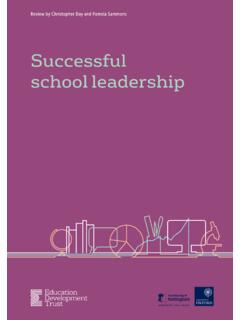Transcription of Supplier Relationship Management (SRM) Identifying and ...
1 Supplier Relationship Management (SRM) Identifying and maximising the value of strategic Supplier partneringAContentsUnlock value through SRM from partnering with strategic suppliers 1 Provide a clear framework and alignment to traditional Supplier Management 1 Establish mutually beneficial relationships with key suppliers 1 Create and monitor sustainable value with SRM processes 2 Overcome challenges of establishing SRM 4 Move from strategy to action 4 Case study: SRM enhancements at a Global Consumer Business Company 5 Unlock value through SRM from partnering with strategic suppliersToday s integrated supply chains need to move beyond traditional cost reduction tactics and explore alternative ways to systematically support the business.
2 Therefore, executives are increasingly looking at re defining their existing Supplier relationships. Supplier Relationship Management (SRM) is one approach to connect the supply chain and their key suppliers with the strategic interests of an organisation , to successfully identify and drive untapped business s Global CPO Survey 2014 found increasing levels of Supplier collaboration and restructuring of existing relationships among the top procurement levels. While in some industries 77% of CPOs may be actively driving innovation with suppliers, the vast majority rates the effectiveness of their strategic Supplier collaborations as poor or this article we examine the need to look beyond traditional Supplier Management , explore how relationships with key partners should be managed in a strategic and holistic manner.
3 And provide high level guidelines on how and where to get started with a clear framework and alignment to traditional Supplier managementIn traditional Supplier relationships the interaction between a company and its suppliers can be described as driven by the operational needs of the different functions. As a result, relationships are in first place lacking transparency with respect to internal governance and ownership of the an external point of view then, suppliers don t see a clear cross functional interface to interact with. As a consequence, they work less efficiently and take advantage of the situation to drive their own effect is further amplified by the organisations growth and acquisition strategies, which may lead to a growing supply network, increasingly global operations and which raise the level of organisational complexity and risk.
4 The ensuing myriad of internal and external stakeholders likely creates a vulnerable network with little global thorough SRM approach provides a clear framework with an internally and externally aligned governance, to manage relationships at all levels and within different functions, reduce the level of complexity and increase transparency on both mutually beneficial relationships with key suppliersThe main objective of Supplier Relationship Management (SRM) is to establish two way, mutually beneficial relationships between an organisation and its suppliers. It consists of collaborative and Relationship building activities, only targeted at the most strategic and critical supply partners that deliver great added value to the firm ( in terms of sustained competitive advantage or innovation).
5 Thereby SRM activities are complementary to Supplier performance and contract Management activities which are targeted at the majority of are observing a number of benefits that companies derive from successfully managing SRM: Reduce costs beyond traditional sourcing and category Management efforts across the entire supply chain through a continuous optimisation of operations in a win win partnership with suppliers. Drive and monitor performance of strategic suppliers in a transparent manner, maintaining focus on key measures that support business objectives. Manage supply risk and compliance with responsible sourcing, ethics and regulatory requirements, by strengthening global transparency and visibility of the Relationship .
6 Foster business development and innovation by jointly Identifying and implementing opportunities that create long term value for both of global CPOs plan to increase their levels of Supplier collaboration in Relationship Management (SRM) Identifying and maximising the value of strategic Supplier partnering1 Create and monitor sustainable value with SRM processesTo enable an organisation to drive more value out of their Supplier relationships, SRM is organised around a set of core complementary processes. These processes focus on Supplier segmentation, SRM governance, Supplier performance Management , and Supplier segmentationSupplier segmentation is the process of categorizing suppliers based on a defined set of criteria in order to identify the key (strategic) suppliers with which to engage in SRM.
7 This selection process is important as not all suppliers require the same level of focus. Organisations should therefore concentrate their resources on a limited number of relevant strategic suppliers (tier 1).These relationships are typically prioritized according to both spend and a set of business criticality criteria reflecting the strategic importance of the Supplier to the organisation . The segmentation process is a prerequisite to set up effective SRM SRM concentrates resources on a limited number of strategic suppliers. SRM governanceEstablishing effective governance is key to unlock SRM value. Fundamental steps are the alignment within the organisation , and the setup of internal governance processes together with clearly assigned ownerships of Supplier relationships.
8 The ownership of the Relationship can be outside of the Procurement organisation , therefore it is essential to involve the right stakeholders from the business in the process. These stakeholders are part of a formal Supplier governance committee for each tier 1 Supplier . A governance committee for example can define and drive the strategic roadmap together with the Supplier . Top level strategic objectives with each tier 1 Supplier are to be mutually agreed at the top level on both sides (in top to top meetings).Data Governance Supplier Development Performance Management Segmentation Tier 3 suppliers Tier 2 suppliers Tier 1 suppliers Supplier Relationship Management Traditional Supplier Management 2 These objectives are essential in driving the setup of operational measures and metrics to be monitored as part of the performance Management process.
9 CXO Functions Plant CXO Functions Plant organisation contact points Supplier contact points organisation Supplier Performance managementPerformance Management involves the setup and continuous tracking of operational measures which are mutually agreed with tier 1 suppliers through SRM governance. It focuses on the critical few measures, which are consolidated on a single Supplier scorecard and relevant for the business. Subsequently it enables a global, shared view of Supplier performance along a common set of defined metrics which should be cascaded down the organisation (local, regional, global levels). Metrics usually also include compliance with the organisation s values and standards ( financial stability, business continuity, responsible sourcing), as well as with laws and relevant industry in place, the Supplier scorecard needs to be continuously monitored and review meetings should be regularly held with strategic suppliers.
10 Any deviation from agreed minimum performance requirements should be addressed immediately by Identifying the root cause and putting in place corrective measures. Supplier developmentOnce segmentation, governance and performance Management are established processes, they represent a springboard to additional value creation activities that can be undertaken with strategic suppliers. Joint business development between an organisation and its tier 1 suppliers is an example of those additional activities that can be derived from SRM. This would typically involve sharing of plans between the two entities and jointly defining initiatives that create long term value for both organisations, such as: Innovation agenda, aligning Supplier s creative efforts to business needs and providing the right platform to enable appropriate feedback on innovation proposals.












![[Draft] European Sustainability Reporting Standard G2 ...](/cache/preview/1/b/d/8/0/0/0/b/thumb-1bd8000bf981ed16b3b23735278f0aeb.jpg)

